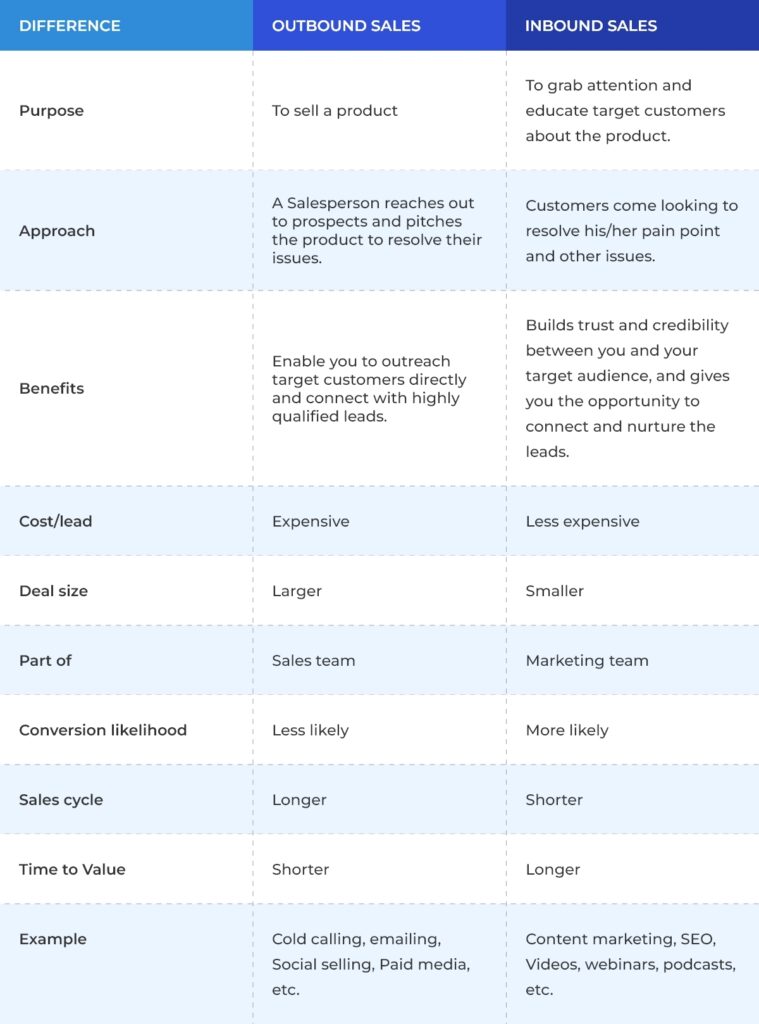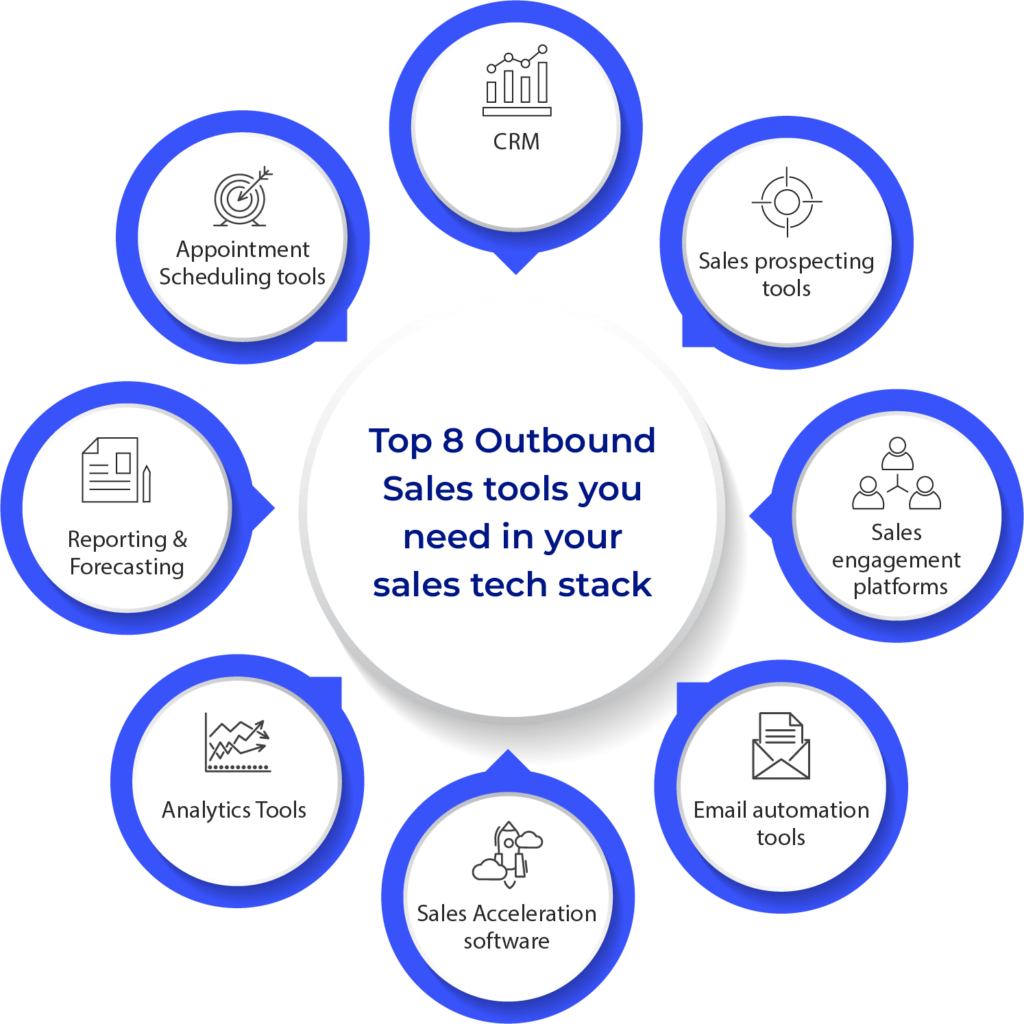
Introduction
Are you a founder of a startup, hesitant to dive into the world of outbound sales? Perhaps you’re uncertain of where to start, what challenges to expect, or what metrics to measure. If yes, this outbound sales guide is for you.
The truth is, outbound sales can be a daunting task, but it’s also an essential component of growing your business. In this guide, we’ll provide you with a–
- Comprehensive overview of outbound sales,
- Inbound vs Outbound Sales
- Challenges you may face,
- Best practices and strategies you need
- Key performance indicators (KPIs) to track,
- Factors to look out for while hiring an SDR
- Effective processes to implement, and
- Valuable tools to utilize.
Whether you’re a seasoned entrepreneur or just starting out, with the right information and guidance, you can make the learning curve shorter. This is the only outbound sales guide that you need to understand the process better.
What is Outbound Sales
Outbound sales refer to a sales strategy that involves proactively reaching out to potential customers to offer them products or services.
This strategy is also known as proactive selling, as the sales development representatives (SDRs) take the initiative to make contact with potential customers. SDRs typically reach out to their prospects via phone, chat, LinkedIn, etc.
Outbound sales are mainly used in B2B sales, but it can also be used in B2C sales also.
Benefits of the outbound sales process
In short, outbound sales are an essential part of the sales strategy for B2B SaaS companies, as they provide a direct line of communication with potential customers, allow for a wider reach, provide valuable data, help to address objections, and close deals.
Some of the other benefits are-
- Highly specific prospecting strategies
- Proactive strategy
- Greater ROI
- Immediate feedback
- Personalized customer touchpoints
Suggested Read: Why is outbound sales going to be an important strategy in 2023?
Inbound vs Outbound sales
Choosing the appropriate sales strategy can be a daunting task for any B2B SaaS start-up. The options to consider are inbound and outbound sales strategies, both of which are popular.
Inbound sales is an inexpensive and scalable option, while outbound sales is an effective method for building customer relationships and finalizing transactions.
It is critical to comprehend the distinctions between inbound and outbound sales to make an informed decision.
Key points of differences- Inbound vs Outbound sales

Check out the blog Inbound Vs Outbound Sales: A Comparative Analysis to know the pros and cons of each type of sales, and much more.
There are many B2B SaaS companies that have demonstrated success in Outbound Sales. Some of them are as follows-
- Salesforce
- ZoomInfo
- Gong
- Outreach
- Freshworks
To determine the ideal approach for your company, you must analyze the advantages and disadvantages of both of them. Nonetheless, the most effective approach usually involves a blend of both inbound and outbound sales strategies.
What is an outbound sales process
Definition of the Outbound sales process
An outbound sales process refers to the specific steps and techniques that a salesperson takes to reach out to potential customers, engage with them, and ultimately close a sale. This process is designed to be efficient, effective, and result-oriented.
Steps in the Outbound Sales process
Let’s look at the common steps involved in the outbound sales process of a B2B SaaS company.
Lead Generation
The first step in the outbound sales process is to identify and generate a list of potential customers. This is typically done through lead-generation techniques such as research, networking, and advertising.
Qualifying Leads
Once the leads have been generated, the next step is to qualify them. This involves determining whether the lead is a good fit for the product or service being offered and whether they are likely to become a customer.
- Contacting Leads: After the leads have been qualified, the next step is to make contact with them. This is typically done through telemarketing, email outreach, or social selling. The goal of this step is to engage the lead and build rapport.
Building Rapport and Establishing Trust
The next step is to build rapport with the lead and establish trust. This involves creating a positive relationship and making the lead feel comfortable with the salesperson and the product or service being offered.
Presenting the Product
Once rapport has been established, the next step is to present the product or service to the lead. This involves explaining the features and benefits of the product or service and how it can meet the needs and goals of the lead.
Addressing Objections and Concerns
After the product or service has been presented, the next step is to address any objections or concerns that the lead may have. This involves providing additional information and addressing any questions or concerns that the lead may have about the product or service.
Closing the Sale
The final step in the outbound sales process is to close the sale. This involves asking the lead to make a purchasing decision and securing their commitment to purchase the product or service.
This blog- Outbound Sales Process: A Beginner’s Guide (2023)– has a detailed description of actionable steps that you need to take your outbound sales game to the next level.
By following these steps, a salesperson can efficiently and effectively engage with potential customers, present their product or service, address objections and concerns, and close more sales.
Outbound Sales Best practices and strategies
While adhering to a structured sales process is crucial, it’s inevitable that you’ll encounter challenges along the way. The good news is that these obstacles don’t have to be so daunting. Incorporating the following outbound sales best practices can help:
- Market Segmentation: Divide your target market into smaller groups with similar needs, characteristics, and behavior. This helps in creating tailored campaigns for each group to increase efficiency and relevance.
- Qualified Lead Generation: Use targeted efforts to attract and engage with prospects who are most likely to convert into paying customers. This includes research, inbound marketing, and outbound prospecting.
- Prospect = Everything: Treat every prospect as valuable, whether they show immediate interest or not. Nurture relationships through personalized and relevant communication to increase brand awareness and loyalty.
- Multi-channel Engagement: Reach out to prospects through various communication channels like email, phone, social media, and video to increase your chances of engagement. Create a cohesive and consistent brand image across all channels.
- Handling Objections: Understand and address objections that prospects may have during the sales process. Prepare and practice responses to common objections to build credibility and increase the chances of closing the deal.
More best practices and strategies are included here: Outbound Sales Best Practices To Boost Your ROI
Top 8 Tools & Techniques for your Outbound sales
A Sales tool is nothing but tech. Yes, the tech that you use to identify, communicate with, inform, engage, persuade, and convert new customers. So, you need these outbound sales tools for your prospecting journey.

These are the top 8 categories of tools required in your sales tech stack.
- CRM
- Salesforce, HubSpot, Pipedrive, etc.
- Sales prospecting tools
- LinkedIn Sales Navigator, Lusha, etc.
- Sales engagement platforms
- Salesgear, Mailshake, Clearbit., etc.
- Email automation tools
- Mailchimp, Sendgrid, Mailerlite, etc.
- Sales acceleration tools
- Clari, Nimble, Salesloft, etc.
- Analytics tools
- Zoho Analytics, HubSpot sales hub, Alteryx, etc.
- Sales Forecasting and Tools
- Gong, Aviso Insights, InsightSquared, etc.
- Appointment Scheduling Tools
- Appointy, Calendly, Simplybook.me, etc.
Need more details about these tools? Check out our blog on the Top 8 outbound sales tools. The 3 techniques that you should use in your sales process are-
- Planning your email outreach
- Social selling
- Cold calling.
Combining these tools with techniques is sure to give success to your outbound sales strategy.
Outbound Sales Job Description
Skills required for Outbound sales
The ideal outbound sales representative should have the following skills and qualifications:
- Excellent communication skills, both written and verbal
- Strong interpersonal skills, including the ability to build relationships and rapport with potential customers.
- A strong understanding of the sales process and the ability to close deals
- A driven and motivated personality, with a focus on achieving sales targets
These skills make a sales rep successful in his/her sales profession.
Average Salary and Job Prospects
The average salary for an outbound sales representative ranges from $40,000 to $60,000 per year, depending on experience and location. The job outlook for this role is positive, with demand expected to grow as B2B SaaS companies continue to expand their sales teams.
You should also create a sales compensation plan depending on your sales goals & targets, the company’s budget & expenses, culture, values, and market rates.
Here’s a detailed article on how to successfully hire your first salesperson – First Sales Hire: A Guide for B2B SaaS Founders
Best KPIs to track outbound sales performance
While you can follow all the strategies in the world to get your prospect’s attention, it’s important to define ways to measure the success of these sales strategies and initiatives.
You can do this by tracking KPIs because they provide insights into the performance of the sales team, help identify areas for improvement, and enable the manager to make data-driven decisions.
Here are some of the major categories of KPIs you should be tracking –
- Lead generation: This category focuses on measuring the success of the sales team in generating leads and attracting potential customers. KPIs in this category include lead quality score, lead conversion rate, response time and lead volume.
- Sales productivity: The sales productivity KPIs measure the effectiveness and efficiency of sales reps in generating revenue. This involves tracking metrics around daily activities like number of emails sent, open rate, reply rate, meetings booked, opportunities created and more.
- Sales performance: This refers to the overall success and effectiveness of a sales team in achieving their goals and targets. It involves various aspects of sales such as pipeline management and tracking, deal closing and negotiation strategies, and sales forecast and quota tracking.
- Customer satisfaction: The customer satisfaction metrics is all about whether the customer loves your product or not. Net Promoter Score (NPS) and Customer Satisfaction Score (CSAT) are the major ones tracked by a B2B Saas company.
- Customer acquisition: This category measures the success of the sales team in acquiring new customers. KPIs in this category include customer acquisition cost (CAC), customer lifetime value (CLV), and customer retention and churn rate.
Check out this article to learn more about these metrics [has a free template to calculate the metrics] – Mastering Outbound Sales KPIs.
What are some of the challenges in outbound sales
If you are a founder of an early-stage startup, you are more likely to focus on reaching out to potential prospects, looking for qualified leads, booking meetings with them, and trying to close deals as soon as possible.
But fear of rejection or failure is a common barrier in outbound sales, and it’s important to push through and stay focused on the end goal.
Many B2B companies such as Mailchimp, Intercom, Pipedrive, Hubspot, etc. have utilized outbound sales strategies in their early stages and have been able to achieve significant success.

Check out this article to learn more about the challenges in B2B sales and how to overcome them.
Outbound Sales FAQs
What is B2B Outbound Sales?
B2B outbound sales refers to the process of reaching out to businesses to sell a product or service. This type of sales is typically focused on building relationships with key decision-makers within a company and presenting them with a solution that meets their needs.
B2B outbound sales often involves more complex sales processes and longer sales cycles than B2C sales.
What is an example of outbound selling?
An example of outbound selling would be a sales representative reaching out to potential customers by phone or email to introduce a product and build relationships.
This type of selling is proactive, as opposed to reactive, and involves reaching out to potential customers rather than waiting for them to reach out to you.
What is B2B outbound calling?
B2B outbound calling is the process of making sales calls to other businesses with the goal of selling products or services. This is common in the B2B SaaS space, where companies are often selling to other businesses rather than consumers directly.
Are outbound calls cold calls?
Outbound calls can be considered cold calls if they are made to potential customers who have not expressed any interest in the product or service being sold. However, outbound sales can also be warm calls if the salesperson has had prior interactions with the prospect, or if the prospect has expressed some level of interest in the product.
How many outbound calls per day?
The number of outbound calls per day varies depending on the company’s goals, resources, and the complexity of the sales process. On average, a salesperson makes between 50 to 100 outbound calls per day. However, this can vary greatly depending on the product or service being sold and the target audience. Some salespeople make fewer calls per day and focus on building stronger relationships with their prospects, while others make more calls and focus on reaching as many prospects as possible.
Are outbound sales hard?
Outbound sales can be challenging, but it can also be highly rewarding for those who are willing to put in the time and effort. To succeed in outbound sales, you need to be organized, confident, and able to handle rejection.
You also need to have a deep understanding of your product or service, your target audience, and the sales process. With the right preparation and mindset, outbound sales can be an enjoyable and successful career path.
What is an Outbound Role?
An outbound role refers to a position within a company that is focused on reaching out to potential customers to sell a product or service.
Outbound sales roles typically require excellent communication skills, a deep understanding of the sales process, and the ability to build relationships with prospects.
Outbound sales positions can be found in a variety of industries, including technology, finance, and healthcare.
Key takeaways
This outbound sales guide is the one that as a founder you were looking for until now.
- Outbound sales can be a highly effective way to grow your business, but it requires a dedicated effort and a strategic approach.
- Inbound and outbound sales are not mutually exclusive, and a combination of both can be a powerful way to generate leads and close deals.
- Challenges in outbound sales can include finding the right prospects, managing rejection, and scaling your efforts effectively.
- Best practices and strategies for outbound sales may include developing a strong value proposition, personalizing your outreach, and using multiple channels to reach your target audience.
- KPIs to track may include metrics like conversion rate, response rate, and pipeline growth.
- When hiring an SDR (sales development representative), important factors to look for may include communication skills, problem-solving ability, and a strong work ethic.
- Effective processes to implement may include creating a clear outreach cadence, prioritizing follow-up, and incorporating feedback into your approach.
- Valuable tools for outbound sales may include CRM software, email automation platforms, and sales enablement tools.
By following the best practices outlined in this guide and using the right tools and processes, you can build a successful outbound sales strategy that drives growth and revenue for your startup.